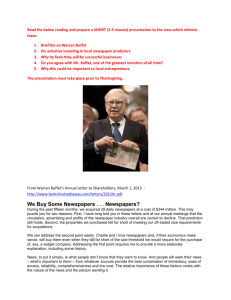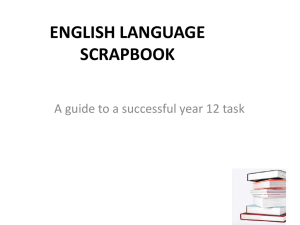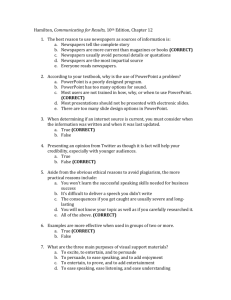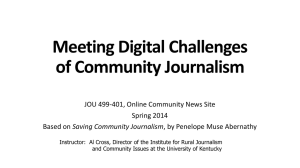National Newspapers Ireland
advertisement
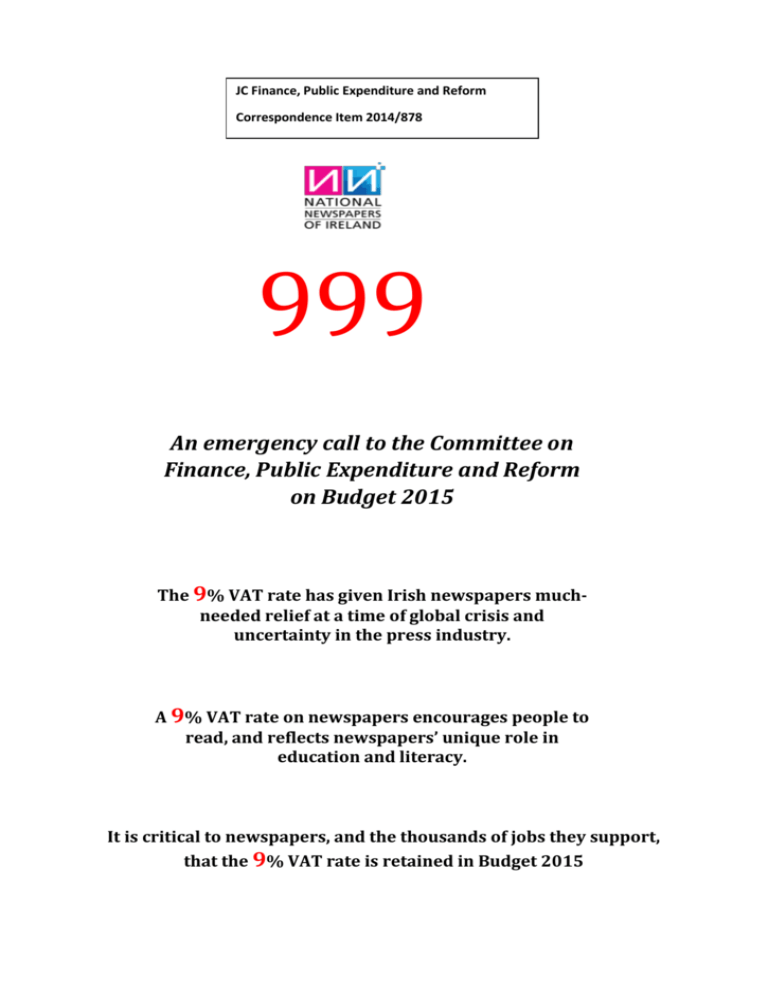
JC Finance, Public Expenditure and Reform Correspondence Item 2014/878 999 An emergency call to the Committee on Finance, Public Expenditure and Reform on Budget 2015 The 9% VAT rate has given Irish newspapers muchneeded relief at a time of global crisis and uncertainty in the press industry. A 9% VAT rate on newspapers encourages people to read, and reflects newspapers’ unique role in education and literacy. It is critical to newspapers, and the thousands of jobs they support, that the 9% VAT rate is retained in Budget 2015 Who we are National Newspapers of Ireland (NNI) represents 16 national daily, Sunday and weekly and 25 local and regional news brands. On an average day (Monday-Saturday), almost 3 million people in Ireland read a national newspaper in print and/or online. On Sundays, 2.2m adults, or 60 per cent of the adult population, either pick up a paper or read at least one of Ireland’s national newspapers online. In addition, 1.3m adults read regional newspapers. In total, 84 per cent of the adult population in Ireland read newspapers regularly. An industry evolving It almost sounds like an understatement to say that the newspaper industry has undergone a period of enormous innovation and rapid change. Between writing this submission and the committee reading it, further innovations will have taken place as publishers around the world invest in new models to meet consumer demand for content delivery. It is an ever-evolving process. Over recent years, Irish publishers have invested millions of euro in their business. Not just in the editorial systems and technology needed to provide multi-platform content to the reader but in training and retaining their journalistic staff, honing their skills and expanding their knowledge to ensure that the profession of journalism and the great tradition of writing in Ireland is preserved. The challenges The global newspaper industry has almost been defined in recent years by its transformation. That transformation is ongoing and requires investment. The stark reality is that those that were not in a position to invest in new business models have not survived and that same threat is faced by NNI members on a daily basis. Whilst these and the other challenges facing the industry are well documented, this submission deals exclusively with the issue of VAT on newspapers. Digital v Print As the Committee will be aware, printed and digital newspaper formats are treated differently for VAT purposes across Europe. In Ireland, this means that VAT on digital newspapers is charged at 23% compared to the current 9% on printed newspapers. We understand that this is a matter that falls under the remit of the EU. However, if we may digress for a moment from the remit of this Committee, we believe it is important 2 to point out that the lack of alignment between the digital and print formats, represents a barrier to existing and future investment in the digital environment. Not only has it affected the competitiveness of the newspaper publishing sector, but it does not take into account the evolution of the press in the new media environment. According to a study by PricewaterhouseCoopers, digital circulation of newspapers is expected to increase rapidly in the years to come. They have estimated that daily newspaper unit digital paid circulation will increase from 569,000 units in 2011 (in 16 western European countries) to 7.6 million units in 2015, a compound annual growth rate of more than 100 per cent on average. It is imperative therefore that the VAT anomaly is addressed, a fact already recognised in France where the Government took a decision in January this year that the 2.1% rate of VAT applied to printed newspapers in France would also apply to digital formats. Why are newspapers different The committee will receive many submissions pleading the case for why a particular product or service should benefit from a reduced rate of VAT. Newspapers however are not a product like any other. They are fundamentally different and recognised as such in many EU countries. For that reason, newspapers have historically been included in Annex III of the Sixth VAT Directive because the EU institutions have always recognised their essential contribution to European society and democracy. The role of newspapers in education Many of our European neighbours enjoy a zero rate of VAT on newspapers, including the UK, in recognition of the need for citizens to have greater access to the printed word and also the contribution newspapers make to literacy levels. There is growing concern about literacy levels amongst young people and as part of NNI’s commitment to education, in 2011 we established a dedicated Newspapers in Education initiative – NNI Press Pass - designed to encourage young people to read newspapers and to help address the growing concerns about declining literacy levels in Ireland. NNI has invested hundreds of thousands in NNI Press Pass and it has been an overwhelmingly positive initiative which has been widely welcomed by schools, students and their families. Such is the success of the initiative – now entering its third year – the Dept of Education is exploring the feasibility of including it in the curriculum. Research shows that young readers’ programmes, such as NNI Press Pass, positively influence students’ motivation, literacy levels, academic skills and classroom communications. Newspapers help students to understand their local society, open a window on the wider worlds and provide a basis for active citizenship. 3 Any increase in the rate of VAT on newspapers would impact negatively on our NiE programme, making newspapers less affordable to families who are under increasing economic pressure. The preservation of press freedom Press freedom is one of the core values of a democratic society and a fundamental right which is inscribed in the European Convention of Human Rights and the Charter for Fundamental Rights. Ideally the promotion of press freedom and the accessibility of professional news, views and analysis should not be taxed. However, any increase in the VAT rate will create a barrier for citizens’ access to professional and trusted news content. Impact on media pluralism and diversity Media pluralism is a necessary condition for freedom of speech and contributes to the development of informed societies where different voices can be heard. It means a structure that is comprised of competing, diversified, independent media outlets, covering all corners of society, and conveying a great variety of information and opinion. As mentioned earlier, there have been many newspaper closures in recent years and it is only those that have been in a position to invest in their business model that have survived during this challenging period for the industry. If the VAT rate increases, there will be further casualities which will further impact negatively on media pluralism and the variety of comment and opinion. Impact on local democracy When we talk about the role of newspapers in society, we generally think in terms of the fourth estate, an essential part of a functioning democracy. Extending that thought to local communities, there are many local and regional newspapers in Ireland that are a key part of the community. These newspapers provide essential local news to citizens, reporting on local sporting events, parish organisations, what’s happening in the community etc. Without local newspapers, who will report County Council meetings and the Courts? Local newspapers have a long-standing tradition of representing and standing up for their readers. They are very often the most effective voice of the community. 4 Local newspapers in Ireland are already under threat with many closures in recent years. There is absolutely no doubt that the Government’s decision to reduce VAT to 9% in May 2011 served as a real fillip to the industry during these challenging times. Impact on sales In view of the extremely precarious financial position of newspapers today, an increase in VAT could not be absorbed by the publishers thus forcing them to raise their cover prices. This would undoubtedly accelerate the ongoing decline in sales – thereby offsetting any potential gain to the exchequer. Sales of NNI newspapers have already fallen by 37% since 2007. Our estimates show that, in the case of a daily newspaper, an increase in cover price would accelerate the decrease in sales by more than 3%. That’s equivalent to a drop in sales of 95,000 for NNI daily newspapers per week. For Sunday newspapers, we estimate a decrease of 2% or approximately 15,000 newspapers per week. Impact on jobs A total of 4,494 people are employed on a full time basis in the newspaper industry in Ireland. This include 3,419 people who are employed within publishing houses (of which 2,096 are editorial staff) whilst a further 1,075 are employed in printing and distribution. Wages across the industry totalled €251.71m in 2011, while freelance journalists and contributors were paid an additional €40m approximately in fees. Thousands more are employed in related industries such as outsourced activities and, as mentioned above, in the 3800 retail outlets that rely heavily on newspaper sales. On paper, it appears that an increase of 1% in VAT, would results in a gain of €4m to the exchequer. The reality is however that the impact of the VAT increase, as argued above, will lead to an accelerated decline in sales which will result in newspaper closures putting these thousands of jobs at risk. Job losses that will ultimately cost the State as the live register increases. Impact on local shops nationwide It is also worth remembering that there are many related industries that rely on newspaper sales, including the local shop or newsagent. Newspapers are sold in 3800 outlets in Ireland and it is estimated that approximately 40% of the local shop’s revenue is generated from newspaper sales. Obviously additional revenue is generated from other purchases made by the customer who popped in to buy their newspaper. Around Ireland, the local shop/newsagent is struggling. The reduction in VAT on newspapers certainly served as a boost to these businesses. For example, in the year preceding the introduction of the 9% VAT, 18 newsagents were going out of business 5 every month within the 26 counties. Since the VAT reduction that figure has dropped to 10 agents per month, or 45% less newsagents closing down. If the VAT rate on newspapers increases, sales of newspapers will decline leading to less customers going to their local store. This will impact on local employment as well as having a social impact. The local newsagent or convenience store is often a central hub of a community and the social consequences of any closures are far-reaching. Rural Ireland, in particular, has fared particularly badly in this recession, with the closure of Post Offices, pubs and Garda stations a common occurrence. In many rural localities the local shop is all that is left to provide a vital community service. NNI believe that the government should be doing everything in its power to preserve these shops and retention of the 9% VAT rate will go a long way to safeguarding their existence. Conclusion The Irish newspaper industry has been in existence for over two hundred years and the NNI publishers are aiming to be here for another two hundred years in whatever new formats are available. But we need the support of the Government. The challenges facing us are mani-fold. As mentioned already, circulation has declined by 37% since 2007 and newspaper print advertising revenues by 62% since the high of 2007. Currently digital advertising revenue accounts for just 10% of the overall total and the industry is struggling to replace declining print revenues with new sources on the digital side. We are however committed to investing in the future of the industry, in the development of a successful and sustainable digital press market which will drive new jobs and growth in the digital economy. We are investing in content, in new formats, in innovative means of delivery and in our employees. We are also investing in education through NNI Press Pass. We have invested hundreds of thousands in the Office of Press Ombudsman and Press Council so that our readers have access to a mechanism for making complaints about newspaper articles that is free to them and totally independent. We have also invested in a dedicated environmental initiative, implementing a very successful voluntary producer environmental responsibility programme. NNI is committed to this on-going investment and to sustaining the industry for the next generation of news consumers. We want to ensure that the press sector continues its vital role in stimulating democratic debate and civic engagement on print and digital platforms, to the benefit of society; We estimate that it would cost the industry approximately €18m to absorb a VAT increase of 4.5%. If the increase is passed on to the customer, we have outlined how this will impact on sales and lead to newspaper closures, an increase in the live register 6 and would have a hugely negative impact on media pluralism and diversity, the democratic debate and also on local Irish communities. The NNI newspapers would welcome and appreciate the opportunity to appear before the Committee to explore the matters raised in this submission further. Thank you. Ends June 2014 7



